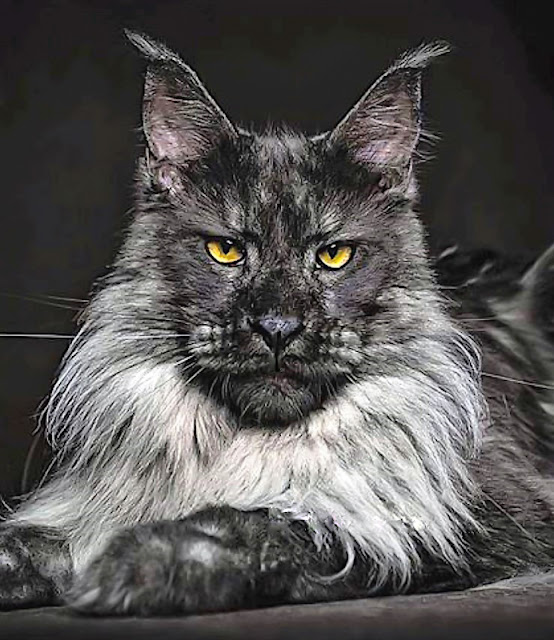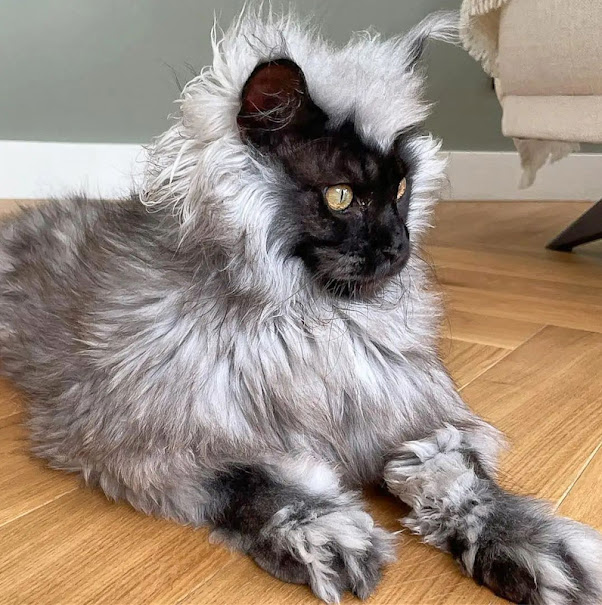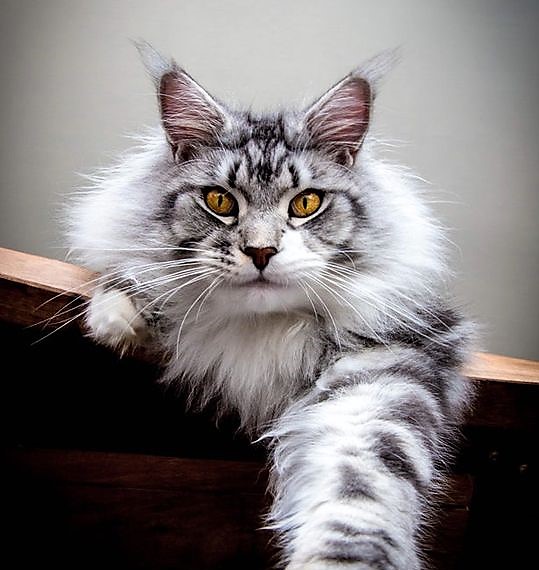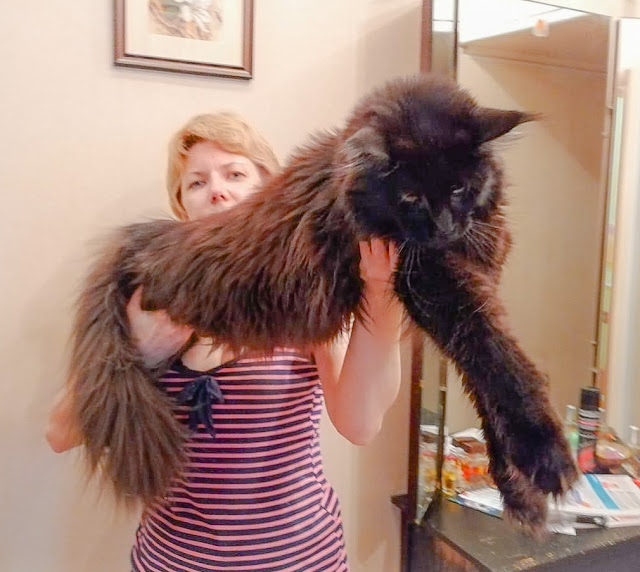7 potential Maine Coon behavioral problems
 |
| Image: MikeB |
Below is a list of seven potential Maine Coon behavioural problems from a well-known website about this cat breed. I would like to discuss them. The picture that I have made hints at the fact that I question whether these really are genuine Maine Coon problems. They are clearly natural behaviours because everything that a Maine Coon cat does is essentially natural; a reaction to the circumstances under which they find themselves and for a Maine Coon cat those circumstances are invariably created by their human caregiver because nearly all Maine Coon cats are full-time indoor cats. They live inside a human world; a human environment both in terms of the inanimate objects and the animate objects.
- Aggressive
- Territorial
- Clingy
- Inappropriate Climbing
- Spraying
- Scratching Furniture
- Destructive
Aggression
Of course, Maine Coon cats can be aggressive. Their inherent character trait lends this cat to be pretty calm and unaggressive; perhaps, in general, less aggressive than a typical domestic cat. But that doesn't exclude them from being aggressive from time to time but the aggression will be provoked in them. A most typical cause of aggression in a domestic cat including the Maine Coon cat would be defensive aggression. They might feel threatened for whatever reason.It might be that they've seen a stray cat outside the window in the backyard. That cat might regularly wander through the backyard. The Maine Coon cat might consider the backyard to be part of their home range i.e. their territory. They would therefore regard that stray cat as an invader upon their territory and they want to do something about it but they can't because they are confined to the indoors.
They might become aggressive. They might direct their aggression not against the stray cat that they can see regularly but a person, perhaps a visitor to the home where the cat lives. Something might trigger it but they might bite that person on their leg. That would be what is called redirected aggression.
Another possibility is that their owner is not a very good person. They might drink too much for example. And when they drink, they might become aggressive. They might be irritated at their cat because he or she follows them around and is underfoot. They might kick the cat. The cat might retaliate. That's aggression but it would be provoked.
A Maine Coon cat might live in a home where there are two other cats. They might not get on well with one of those cats. They might fight occasionally. Cats can be friendly with cats and they can be unfriendly with cats. This background unfriendly this might lead to the odd bit of agonistic behaviour.
One cat might be bullying Maine Coon cat which occasionally results in the Maine Coon retaliating.
Or the Maine Coon might be ill and in pain. For example, we know that the Maine Coon cat suffers from hip dysplasia. I can be painful. They might become irritated. Their owner might inadvertently cause their cat pain when picking them up slightly brusquely. This might cause their cat to nip them. The person might think that their cat is aggressive but he or she isn't. The cat thinks that their owner caused the pain and therefore they are defending themselves.
There are countless reasons why a Maine Coon cat might become aggressive when they are otherwise very calm, normal and well-balanced. When a cat becomes aggressive it is normal and natural and there will be a good reason for it. It will require an assessment by the owner and the answer will be found within the owner's environment that they have created. The owner must start in their diagnosis of the cause by looking at what they are doing and what others are doing in the home.
Territorial
Like all domestic cats, Maine Coon cats are territorial. They have a home range like any other domestic cat which is the territory which they regard as there is. This will be a very confined and compressed territory if they are full-time indoor cats because it will be encompassed by the walls of the home. And if they share their home with other cats their home range will even be more compressed. This will require a certain amount of adjustment and adaptability by the Maine Coon cat.
The indoor Maine Coon cat has to live in a home range which is markedly smaller than they would naturally prefer. There may be scuffles with other cats within the home about access to their home range.
 |
| Image: MikeB |
And I've mentioned above under the subheading "aggression" that a cat might look out the window and see a stray cat walking on their territory. As mentioned, this may lead to redirected aggression.
Cat owners should be aware of domestic cats' natural desire to own a home range. For the full-time indoor cat, it will often be a shared home range with other cats. This works okay but it does require adaptability.
I would say that the instincts of a domestic cat to have a home range is the biggest source of problems within multi-cat homes confined to the home.
Clingy
I would be surprised if a Maine Coon cat is clingy. They might be. This means the cat always likes to be with their owner; almost glued to their owner as if they are kitten following their mother around. They might relate to their owner as a surrogate mother because that person might raise them as a newborn kitten. This will lead to a very close bond and that bond might be manifested in clingy behaviour from the owner's perspective.
Anthropomorphising the cat
I think that would be a misplaced perception. I would prefer to look at it as a close bond as mentioned and therefore something nice. The word "clingy" has negative connotations. Arguably, it is anthropomorphising (humanising) the domestic cat. I don't think domestic cats are clingy as such. They can be close emotionally to their owner or another person in the home which I would argue, as mentioned, is a good behavioural trait.
People generally want their domestic cat companion to be interested in interacting with them, coming to them, sitting on their lap, engaging with them. This is a positive behavioural trait.
Inappropriate climbing
This applies to Maine Coon cats jumping up on counters, climbing up furniture and perhaps jumping up onto the tops of doors or a mantelpiece and knocking something off the mantelpiece. All totally normal behaviour for any domestic cat including Maine Coons. You know that the domestic cat, unlike humans, live both horizontally and vertically. They are excellent climbers as you also know and they like to exercise that skill by going vertical. They need to exercise that desire as it is inherited in their behaviour.
The answer is to provide them with some climbing materials such as a tree; even one which goes to the ceiling in a room. This is about "environmental enrichment". It's about adapting your home to make it comfortable and suitable for both the owner and the cat. It is almost a situation of equal rights in that regard. Very few owners actually provide enough climbing material for their domestic cat or enrich their home enough.
But the pressure is on Maine Coon owners who keep their cats indoors full-time to focus quite a lot more on environmental enrichment. It's a way of reducing boredom in a cat which can lead to overeating. It can lead to unwanted behaviours. A cat can become obese because they eat for pleasure and then spend most of the time sleeping. Particularly if they are allowed to graze freely on dry cat food.
Spraying
You know that spraying is marking territory with urine which is ejected horizontally onto vertical surfaces normally. This is marking territory to leave a 'calling card' that this is their home range. We are back to the home range topic mentioned above. If a Maine Coon cat is marking territory within the home which would be unusual, it is because they are stressed by one of a number of factors one of which might be that another cat is bullying them and compressing their home range space intolerably.
They might be spraying not to mark territory but to make their home feel more friendly. They might defecate as well for the same purpose. They might feel that the home is unfriendly and stressful because the owner might be away far too much. Or there may be so much activity in the home which creates noise making it a stressful environment. Cats mark territory to reassure themselves; to calm themselves down temporarily.
If a Maine Coon cat is spraying inside the home, then the owner should look to their environment and search for the cause of why their cat is stressed. They should look to themselves first.
Urinating inappropriately
The owner should distinguish between spraying, as described above, and urinating inappropriately outside the litter box which will be due to other reasons including the litter box is badly situated or not been cleaned enough or another cat is defending resources in an act of bullying or the Maine Coon cat is suffering from cystitis which is strongly exacerbated by stress.
Scratching furniture
Anybody who is involved in domestic cat caretaking knows what this is about. Domestic cats need to scratch usually vertical surfaces to exercise their extensor muscles which retract and protract their claws. They need to scratch these surfaces to deposit scent as a means of marking territory. They also scratch vertical surfaces to exercise their back and to slough off the outer cuticle of their claws to sharpen them. All good reasons why cats scratch vertical surfaces and if a sofa or armchair is in the home it is an ideal object upon which to carry out these exercises.
You know the alternative which is to place a very big (the biggest you can buy) scratching post next to the furniture being scratched and then gradually relocated to a more acceptable position. The post can be made more attractive to the cat by rubbing cat nip on it.
You can buy several horizontal scratching boards as well. Combination of these scratching devices will pretty well eliminate scratching furniture if in addition you place double sided sticky material on the armchair where it is being scratched. You can buy this material on Amazon. You can also buy the best scratching post on the market on Amazon.
Destructive
Destructive behaviour would be unusual but it might mean destroying a toilet roll which you might have seen on YouTube video. Normally a Maine coon cat would be destructive when playing with a toy which can be destroyed (ideally) in order to mimic a real prey animal.
If a cat is jumping up onto mantelpiece and knocking items off the mantelpiece that is not wanton destruction. It is a bored cat trying to amuse themselves by animating an inanimate object. The cure for that is to make their lives more interesting and challenging.
A lot of good healthy play with a domestic cat throughout the day if the time is available to the owner will certainly help to eliminate so-called destructive behaviour but as I said I think this would be highly unusual.











Comments
Post a Comment
Please share your Maine Coon experiences.